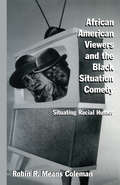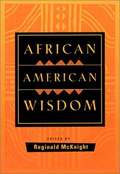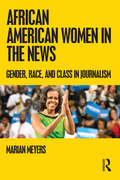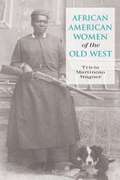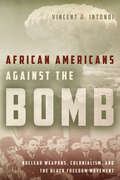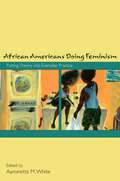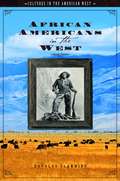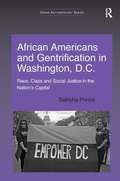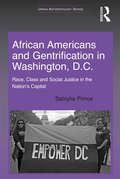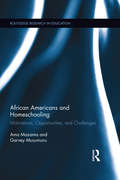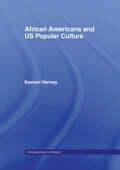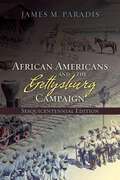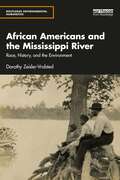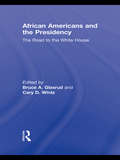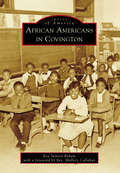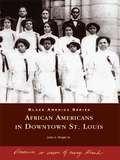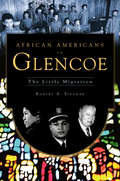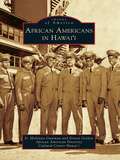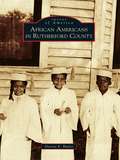- Table View
- List View
African American Viewers and the Black Situation Comedy: Situating Racial Humor (Studies in African American History and Culture)
by Robin R. Means ColemanProviding new insight into key debates over race and representation in the media, this ethnographic study explores the ways in which African Americans have been depicted in Black situation comedies-from 1950's Beulah to contemporary series like Martin and Living Single.
African American Wisdom (revised and expanded edition)
by Reginald Mcknight"A new broom sweep clean, but an old brush knows the corners." --Anonymous There's a time when you have to explain to your children why they're born, and it's a marvelous thing if you know the reason by then. --HAZEL SCOTT Love, I find is like singing. Everybody can do enough to satisfy themselves, though it may not impress the neighbors as being very much. --ZORA NEALE HURSTON This is a wonderful collection!
African American Women in the News: Gender, Race, and Class in Journalism
by Marian MeyersAfrican American Women in the News offers the first in-depth examination of the varied representations of Black women in American journalism, from analyses of coverage of domestic abuse and "crack mothers" to exploration of new media coverage of Michelle Obama on Youtube. Marian Meyers interrogates the complex and often contradictory images of African American women in news media through detailed studies of national and local news, the mainstream and Black press, and traditional news outlets as well as newer digital platforms. She argues that previous studies of African Americans and the news have largely ignored the representations of women as distinct from men, and the ways in which socioeconomic class can be a determining factor in how Black women are portrayed in the news. Meyers also proposes that a pattern of paternalistic racism, as distinct from the "modern" racism found in previous studies of news coverage of African Americans, is more likely to characterize the media's treatment of African American women. Drawing on critical cultural studies and black feminist theory concerning representation and the intersectionality of gender, race and class, Meyers goes beyond the cultural myths and stereotypes of African American women to provide an updated portrayal of Black women today. African American Women in the News is ideal for courses on African American studies, American studies, journalism studies, media studies, sociology studies, women’s studies and for professional journalists and students of journalism who seek to improve the diversity and sensitivity of their journalistic practice.
African American Women of the Old West
by Tricia Martineau WagnerThe brave pioneers who made a life on the frontier were not only male; and they were not only white. The story of African-American women in the Old West is one that has largely gone untold--until now. The story of ten African-American women is reconstructed from historic documents found in century-old archives. The ten remarkable women in Black Women of the Old West were all born before 1900, some were slaves, some were free, and some lived both ways during their lifetime. Among them were laundresses, freedom advocates, journalists, educators, midwives, business proprietors, religious converts, philanthropists, mail and freight haulers, and civil and social activists.
African Americans Against the Bomb: Nuclear Weapons, Colonialism, and the Black Freedom Movement
by Vincent J. IntondiWell before Rev. Dr. Martin Luther King, Jr. spoke out against nuclear weapons, African Americans were protesting the Bomb. Historians have generally ignored African Americans when studying the anti-nuclear movement, yet they were some of the first citizens to protest Truman's decision to drop atomic bombs in Hiroshima and Nagasaki in 1945. Now for the first time, African Americans Against the Bomb tells the compelling story of those black activists who fought for nuclear disarmament by connecting the nuclear issue with the fight for racial equality. Intondi shows that from early on, blacks in America saw the use of atomic bombs as a racial issue, asking why such enormous resources were being spent building nuclear arms instead of being used to improve impoverished communities. Black activists' fears that race played a role in the decision to deploy atomic bombs only increased when the U.S. threatened to use nuclear weapons in Korea in the 1950s and Vietnam a decade later. For black leftists in Popular Front groups, the nuclear issue was connected to colonialism: the U.S. obtained uranium from the Belgian controlled Congo and the French tested their nuclear weapons in the Sahara. By expanding traditional research in the history of the nuclear disarmament movement to look at black liberals, clergy, artists, musicians, and civil rights leaders, Intondi reveals the links between the black freedom movement in America and issues of global peace. From Langston Hughes through Lorraine Hansberry to President Obama, African Americans Against the Bomb offers an eye-opening account of the continuous involvement of African Americans who recognized that the rise of nuclear weapons was a threat to the civil rights of all people.
African Americans Doing Feminism: Putting Theory into Everyday Practice
by Aaronette M. WhiteHow might ordinary people apply feminist principles to everyday situations? How do feminist ideas affect the daily behaviors and decisions of those who seek to live out the basic idea that women are as fully human as men? This collection of essays uses concrete examples to illuminate the ways in which African Americans practice feminism on a day-to-day basis. Demonstrating real-life situations of feminism in action, each essay tackles an issue—such as personal finances, parenting, sexual harassment, reproductive freedom, incest, depression and addiction, or romantic relationships—and articulates a feminist approach to engaging with the problem or concern. Contributors include African American scholars, artists, activists, and business professionals who offer personal accunts of how they encountered feminist ideas and are using them now as a guide to living. The essays included reveal how feminist principles affect people's perceptions of their ability to change themselves and society, because the personal is not always self-evidently political.
African Americans In The West
by Douglas FlammingThe story of the African American experience in the Western US, from colonial times to the present, is chronicled in this accessible reference for students in high school and up. The book begins by examining slavery on the moving frontier, and the ways in which the frontier ultimately resulted in the abolition of slavery in America. It continues by examining African American life in the western region as a whole, with material on black cowboys, the rise of the NAACP, the Tulsa race riot, race and organized labor, the era of Black Nationalism, and blacks in Hollywood. The chapter on the African American West since 1980 examines topics including the Rodney King beating, gangsta rap, and suburbanization. The final chapter examines the historiography of the Black West and current issues in multiracial history. A chronology and a glossary are included. Flamming teaches history at the Georgia Institute of Technology.
African Americans and Africa: A New History
by Nemata Amelia BlydenAn introduction to the complex relationship between African Americans and the African continent What is an “African American” and how does this identity relate to the African continent? Rising immigration levels, globalization, and the United States’ first African American president have all sparked new dialogue around the question. This book provides an introduction to the relationship between African Americans and Africa from the era of slavery to the present, mapping several overlapping diasporas. The diversity of African American identities through relationships with region, ethnicity, slavery, and immigration are all examined to investigate questions fundamental to the study of African American history and culture.
African Americans and Gentrification in Washington, D.C.
by Sabiyha PrinceUsing qualitative data, including extensive interview material and ethnographic research, to explore the experiences and ideas of African Americans as they confront and construct gentrification, this book contextualizes black Washingtonians' perspectives on belonging and attachment during a marked period of urban restructuring and demographic change in the nation's capital.
African Americans and Gentrification in Washington, D.C.: Race, Class and Social Justice in the Nation’s Capital (Urban Anthropology)
by Sabiyha PrinceThis book uses qualitative data to explore the experiences and ideas of African Americans confronting and constructing gentrification in Washington, D.C. It contextualizes Black Washingtonians’ perspectives on belonging and attachment during a marked period of urban restructuring and demographic change in the Nation’s Capital and sheds light on the process of social hierarchies and standpoints unfolding over time. African Americans and Gentrification in Washington, D.C. emerges as a portrait of a heterogeneous African American population wherein members define their identity and culture as a people informed by the impact of injustice on the urban landscape. It presents oral history and ethnographic data on current and former African American residents of D.C. and combines these findings with analyses from institutional, statistical, and scholarly reports on wealth inequality, shortages in affordable housing, and rates of unemployment. Prince contends that gentrification seizes upon and fosters uneven development, vulnerability and alienation and contributes to classed and racialized tensions in affected communities in a book that will interest social scientists working in the fields of critical urban studies and urban ethnography. African Americans and Gentrification in Washington, D.C. will also invigorate discussions of neoliberalism, critical whiteness studies and race relations in the 21st Century.
African Americans and Homeschooling: Motivations, Opportunities and Challenges (Routledge Research in Education #125)
by Ama Mazama Garvey MusumunuDespite greater access to formal education, both disadvantaged and middle-class black students continue to struggle academically, causing a growing number of black parents to turn to homeschooling. This book is an in-depth exploration of the motivations behind black parents’ decision to educate their children at home and the strategies they’ve developed to overcome potential obstacles. Citing current issues such as culture, religion and safety, the book challenges the commonly expressed view that black parents and their children have divested from formal education by embracing homeschooling as a constructive strategy to provide black children with a valuable educational experience.
African Americans and Mental Health: Practical and Strategic Solutions to Barriers, Needs, and Challenges
by Mary Olufunmilayo AdeksonThis book enumerates the unique challenges, barriers, needs, and trauma of being an African American in the United States, and at the same time highlights what needs to be done to improve and foster the mental health healing of this population. This includes practical applications and strategic solutions that work, such as the family togetherness and ardent spiritual beliefs that form the basis for resilient and vibrant mental health among African Americans. This contributed volume features the authorship of counseling professionals, most of whom are African American themselves. Because of their own personal experiences, they are able to emphasize cogent helping strategies for this population, to show how to move forward with encouragement. The book also highlights ways to promote life that is mentally healthy and holistic for African Americans.Topics covered within the chapters include:Mental Health Challenges Unique to African American Children and AdolescentsDiagnosis Issues with African Americans Culture of Family Togetherness, Emotional Resilience, and Spiritual Lifestyles Inherent in African Americans from the Time of Slavery Until Now The Trauma of Being an African American in the 21st Century Training, Recruiting, and Retaining African American Mental Health ProfessionalsAfrican Americans and Mental Health: Practical and Strategic Solutions to Barriers, Needs, and Challenges is an essential resource for helping professionals who work with this population, including psychiatrists, counselors, psychologists, social workers, and other mental health professionals. The book also should be of interest to researchers, instructors, and students in Counseling, Social Work, and Psychology.
African Americans and US Popular Culture
by Kevern VerneyThis volume is an authoritative introduction to the history of African Americans in US popular culture, examining its development from the early nineteenth century to the present. Kevern Verney examines: * the role and significance of race in all major forms of popular culture, including sport, film, television, radio and music* how the entertainment industry has encouraged racism through misrepresentations and caricatured images of African Americans. African Americans have made a unique contribution to the richness and diversity of US popular culture. Rooted in African society and traditions, black slaves in America created a dynamic culture which continues to evolve. Present day hip-hop and rap music are still shaped by the historical experience of slavery and the ongoing will to oppose oppression and racism. Any student of African-American history or cultural studies will find this a fascinating and highly useful book.
African Americans and the Gettysburg Campaign
by James M ParadisThe Sesquicentennial edition of African Americans and the Gettysburg Campaign updates the original 2006 edition, as James M. Paradis introduces readers to the African-American role in this famous Civil War battle. In addition to documenting their contribution to the war effort, it explores the members of the black community in and around the town of Gettysburg and the Underground Railroad activity in the area.
African Americans and the Mississippi River: Race, History, and the Environment (Routledge Environmental Humanities)
by Dorothy Zeisler-VralstedThis book follows the historical trajectory of African Americans and their relationship with the Mississippi River dating back to the 1700s and ending with Hurricane Katrina and the still-contested Delta landscape. Long touted in literary and historical works, the Mississippi River remains an iconic presence in the American landscape. Whether referred to as "Old Man River" or the "Big Muddy," the Mississippi River represents imageries ranging from the pastoral and Acadian to turbulent and unpredictable. However, these imageries—revealed through the cultural production of artists, writers, poets, musicians, and even filmmakers—did not reflect the experiences of everyone living and working along the river. Missing is a broader discourse of the African American community and the Mississippi River. Through the experiences of African Americans with the Mississippi River, which included narratives of labor (free and enslaved), refuge, floods, and migration, a different history of the river and its environs emerges. The book brings multiple perspectives together to explore this rich history of the Mississippi River through the intersection of race and class with the environment. The text will be of great interest to students and researchers in environmental humanities, including environmental justice studies, ethnic studies, and US and African American history.
African Americans and the Presidency: The Road to the White House
by Cary D. Wintz Bruce A. GlasrudAfrican Americans and the Presidency explores the long history of African American candidates for President and Vice President, examining the impact of each candidate on the American public, as well as the contribution they all made toward advancing racial equality in America. Each chapter takes the story one step further in time, through original essays written by top experts, giving depth to these inspiring candidates, some of whom are familiar to everyone, and some whose stories may be new. Presented with illustrations and a detailed timeline, African Americans and the Presidency provides anyone interested in African American history and politics with a unique perspective on the path carved by the predecessors of Barack Obama, and the meaning their efforts had for the United States.
African Americans in Covington (Images of America)
by Rev Mallery Callahan Eva Semien BahamCovington is the seat of St. Tammany Parish government and sits north of Lake Pontchartrain in the New Orleans metropolitan area. Records from 1727 show 11 Africans on the north shore. One person of African descent was present at the founding of Covington on July 4, 1813. Most African Americans in antebellum Covington were slaves, with a modest number of free people, all of whom covered nearly every occupation needed for the development and sustenance of a heavily forested region. For more than 200 years in Covington, African Americans transformed their second-class status by grounding themselves in shared religious and social values. They organized churches, schools, civic organizations, benevolent societies, athletic associations, and businesses to address their needs and to celebrate their joys.
African Americans in Downtown St. Louis (Black America Series)
by John A. Wright Sr.Since the founding of St. Louis in 1764, Downtown St. Louis has been a center of black cultural, economic, political, and legal achievements that have shaped not only the city of St. Louis, but the nation as well. From James Beckworth, one of the founders of Denver, Colorado, to Elizabeth Keckley, Mary Todd Lincoln's seamstress and author of the only behind-the-scenes account of Lincoln's White House years, black residents of Downtown St. Louis have made an indelible mark in American history. From the monumental Dred Scott case to entertainers such as Josephine Baker, Downtown St. Louis has been home to many unforgettable faces, places, and events that have shaped and strengthened the American experience for all.
African Americans in El Paso (Images of America)
by Kathryn Smith-Mcglynn Maceo Crenshaw Dailey Jr. Cecilia Gutierrez VenableEl Paso's African American community can trace its origins back to the 16th century, when the black Moor known as Esteban roamed the southwest and, more significantly, those Africans in the party of conquistador Juan de Oñate crossed the Rio Grande in 1598. The modern El Paso African American community began to take shape in the 1880s, as the railroad industry, military establishment, and agricultural community all had black Americans in their ranks. Black leaders and their followers established a school and founded several significant black churches. Texas's first state branch of the National Association for the Advancement of Colored People is recorded to have been formed in El Paso; the first major court cases that challenged the all-white Democratic primary came from this city; the Texas Western College basketball team won the NCAA championship in 1966 with five starting black players; and today, the city is inhabited by black military retirees, entrepreneurs, educators, and other professionals (each with vibrant and socially conscious organizations), making it a progressive model of community development.
African Americans in Glencoe: The Little Migration (American Heritage)
by Robert A. SidemanThe village of Glencoe has a proud history of early African American settlement. In recent years, however, this once thriving African American community has begunto disperse. Robert Sideman, a thirty-year Glencoe resident, relates this North Shore suburb's African American history through fond remembrances of Glencoe communitiessuch as the St. Paul AME Church, as well as recounting the lives of prominent African Americans. At the same time, Sideman poses a difficult question: how can the village maintainits diverse heritage throughout changing times? African Americans in Glencoe reveals an uplifting history while challenging residents to embrace a past in danger of being lost.
African Americans in Hawai'i (Images of America)
by D. Molentia Guttman African American Diversity Cultural Center Hawai'i Ernest GoldenDuring the early 1800s, about two dozen men of African descent lived in Hawai'i. The most noteworthy was Anthony D. Allen, a businessman who had traveled around the world before making Hawai'i his home and starting a family there in 1810. The 25th Black Infantry Regiment, also known as the Buffalo Soldiers, arrived in Honolulu at the Schofield Barracks in 1913. They built an 18-mile trail to the summit of Mauna Loa, the world's largest shield volcano, and constructed a cabin there for research scientists. After World War II, the black population of Hawai'i increased dramatically as military families moved permanently to the island. Hawai'i has a diverse population, and today about 35,000 residents, approximately three percent, claim African ancestry.
African Americans in Memphis (Images of America)
by Earnestine Lovelle JenkinsMemphis has been an important city for African Americans in the South since the Civil War. They migrated from within Tennessee and from surrounding states to the urban crossroads in large numbers after emancipation, seeking freedom from the oppressive race relations of the rural South. Images of America: African Americans in Memphis chronicles this regional experience from the 19th century to the 1950s. Historic black Memphians were railroad men, bricklayers, chauffeurs, dressmakers, headwaiters, and beauticians, as well as businessmen, teachers, principals, barbers, preachers, musicians, nurses, doctors, Republican leaders, and Pullman car porters. During the Jim Crow era, they established social, political, economic, and educational institutions that sustained their communities in one of the most rigidly segregated cities in America. The dynamic growth and change of the post-World War II South set the stage for a new, authentic, black urban culture defined by Memphis gospel, blues, and rhythm and blues music; black radio; black newspapers; and religious pageants.
African Americans in Nacogdoches County (Images of America)
by Jeri MillsTypical of most communities after the Civil War, Nacogdoches's African Americans had to repurpose their lives by building their own communities while they carved a life of survival first and progress second. The images in this book will tell the stories of the first churches and how they became the center of the community. Other images will share information about the early leaders in the community who helped establish educational facilities for "Negroes." Additional images focus on black businesses, and a final set of images will discuss the emerging black middle class and others who played significant roles in Nacogdoches history. Readers of this book will go on a journey, through images, that highlights residents' pains of struggles and gains of triumph.
African Americans in Pittsburgh (Black America Series)
by Carnegie Museum of Art Pittsburgh Courier John M. Brewer Jr.African Americans in Pittsburgh chronicles the distinct trends in this African American community. There was never one centralized neighborhood where a majority of the black population lived, and city schools were integrated until after desegregation laws were passed. Photographs captured by famed Pittsburgh photographer Charles "Teenie" Harris show the candid experiences of residents, including the achievements and celebrations of people struggling to put scraps of food on the table.
African Americans in Rutherford County (Images of America)
by Devora E. ButlerAfrican Americans have heavily contributed to and shaped the unique and vibrant Rutherford County in middle Tennessee. Located 30 miles southeast of Nashville, Rutherford County is at the state's geographical center. This area is home to the Stones River National Battlefield, a national park that was the site of a major Civil War battle--the Battle of Stones River. Tourists come from all over the world to experience this rich cultural and historic venue that once served, although briefly, as the capital of Tennessee. African American men and women have lived, worked, and toiled here for generations.
